This review presents a rather rare version of Helios-44-3 2/58 MS from the Helios-44-X series of lenses.
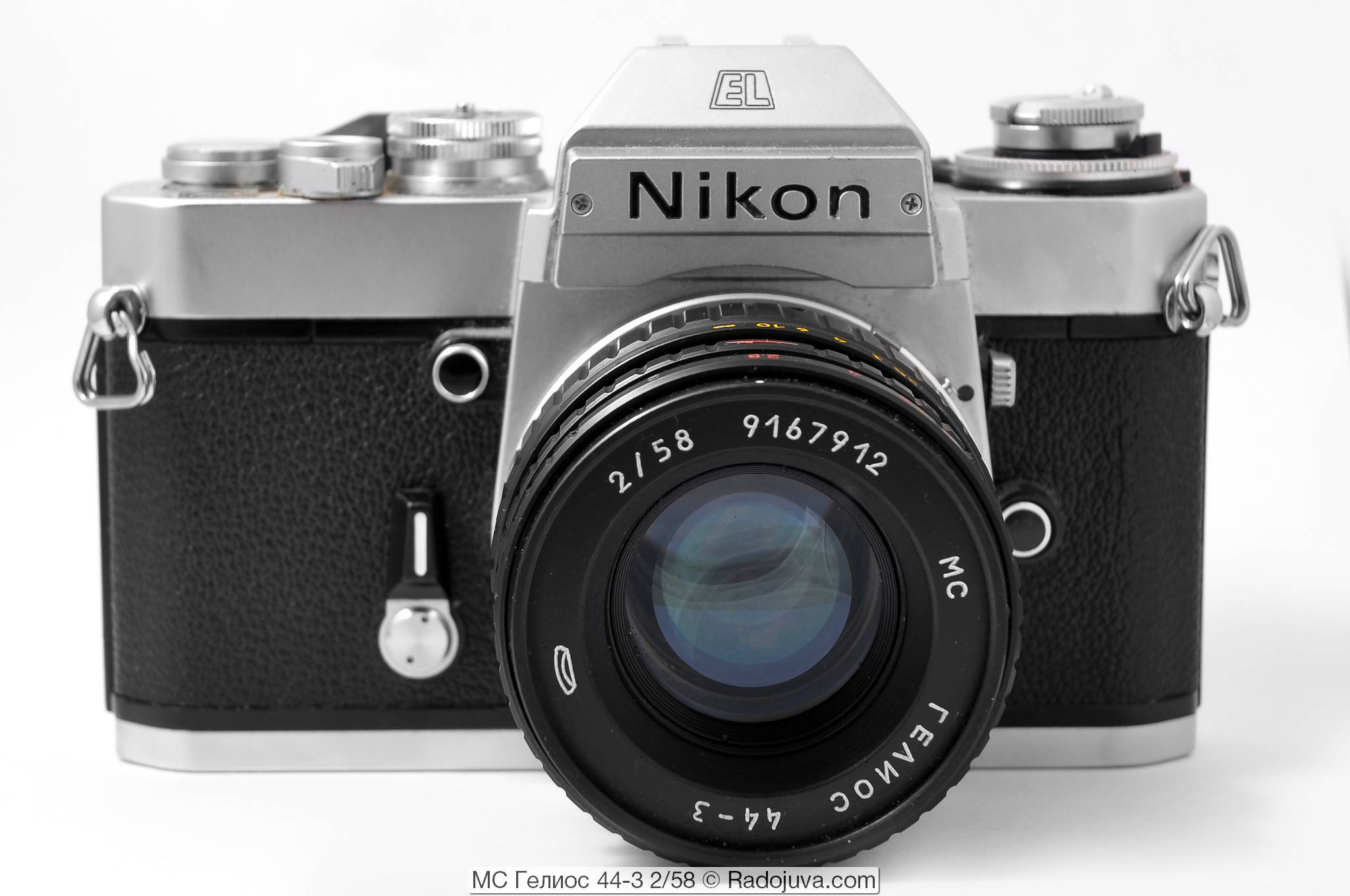
MS Helios 44-3 2/58. Lens shown on a film camera Nikon EL-2 installed using a conventional adapter M42-Nikon F
In short
MC Helios 44-3 2/58 is one of the best lenses among all versions of 'Helios-44' with manual aperture setting. This is the only lens in this series with multi-coated optics.
In general, it looks like very common options Helios-44-2 2/58 (HELIOS-44-2 2/58).
The general list of HELIOS-44 lenses can be found in the 'A Thousand and One Nights with HELIOS-44'.
The main technical characteristics of Helios 44-3 2/58:
| The name of the instance from the review (as it is written on the lens itself) | Helios 44-3 2/58 MS with the VOMZ logo; two lenses participated in the review: 8619437 and 9167912 |
| Basic properties |
|
| Front Filter Diameter | 52 mm |
| Focal length | 58 m |
| Zoom ratio | 1 x |
| Designed by | for film cameras with a frame size of 36 mm X 24 mm |
| Number of aperture blades | 8 rounded petals. Petals form an octagon of approximately regular shape. |
| Tags |
|
| Diaphragm | From F / 2 to F / 16.0, it is regulated by a diaphragm ring, there is a diaphragm preset ring. The aperture can be adjusted smoothly, without clicks. |
| MDF (minimum focusing distance) | 0.5 m |
| The weight | 250 g |
| Optical design | 6 elements in 4 groups |
| Lens hood | screwed into the front filter, marking of the original hood not found. |
| Manufacturer country | USSR, made at the Vologda Optical and Mechanical Plant |
| Instructions | My scan |
| Period | Around 1983 (?) To 1995 (?) |
MC Helios 44-3 2/58 is well built, but from the obvious shortcomings I can note the following:
- the chamfers of the lenses are not blacked out, which adversely affects the contrast of the image
- aperture blades are not blackened, which adversely affects image contrast on covered apertures
- micro-play of the aperture setting ring, but this does not affect the performance or usability of the lens
- the lens hood is screwed into the thread of the front light filter, and is not installed in the bayonet grooves, as in modern lenses. Although, for that time, I do not know any similar lens with a bayonet type hood
- focus ring design poorly compatible with adapters. This trouble will be described in detail below and it relates more to adapters / adapters than to lens flaws
- at F / 4-F / 16 values, the aperture blades form an insufficiently round hole
- For Soviet lenses, a characteristic feature is the presence of a focus distance scale only in meters (metric system). Some Western users may complain about this.
- the focus ring is too close to the mount, it is not always convenient to work, especially when used on some modern cameras, for example, equipped with a battery grip
The focus ring is metal, not rubberized, rotates approximately 270 degrees, the stroke of the ring is smooth. During focusing, the front retractable body does not rotate. Focusing occurs by moving the entire lens block.
MS Helios 44-3 2/58 has a ring presets diaphragm. It allows you to select one of the fixed values: F / 2, 2.8, 4, 5.6, 8, 11, 16. Unlike the preset ring, the aperture setting ring rotates smoothly and can be used to set any intermediate value. The smooth movement of the aperture ring is useful when shooting video. The diaphragm consists of 8 blades that form a hole in the form of regular octahedrons.
Helios 44-3 2/58 MS has an unusual for the Helios-44 series lenses red-yellow marking of the aperture and focusing distance.
The difference between the lenses of the Helios-44-X series and the Helios-44 seriesМ-X is that versions without letter 'М'in the name of the lens do not have a jumping ('Мaperture), therefore, the diaphragm on such a lens works only in manual mode. Such lenses are more convenient to use on modern digital cameras (there is no need to block the mechanism of the aperture jumping device for manual control). Lenses with an 'M' in their name, such as HELIOS-44M 2/58, have a jumping (blinking) diaphragm mechanism and do not have a manual diaphragm control mode (the diaphragm is always open until the diaphragm pin on the bayonet side is pressed).
MS Helios-44-3 is interesting in that it has multi-illuminated optics, as indicated by the letters MS in the name of the lens (МultiproСbranching). MS versions are rare, and usually these are Helios-44 lensesМ-X, not Helios-44-X series.
Difficulty using with adapters
MC Helios-44-3 2/58 has one very characteristic and unpleasant feature. When using the adapter, which is screwed onto the native thread of the M42, it rests against the focusing ring and locks it (the focusing ring cannot be rotated). There will be serious focusing problems with any 'M42-desired mount' adapter. I only observe this design of the focusing ring on MC Helios 44-3 2/58. To treat this ailment, either cut the back of the focusing ring a little or use a homemade thin spacer between the focusing ring and adapter.
It's important: all lenses manufactured before 1991 suffer from this ailment. After 1991, the lens was finalized and its use with adapters / adapters does not cause any problems.
Important: Helios-44-3 MS 2/58 using a conventional adapter M42-Canon EOS can catch a mirror full-frame Canon EOS cameras. So MC Helios-44-3 2/58 clings to the mirror of my Canon EOS 5D camera during focusing from infinity to 6 meters. FROM cropped Canon EOS camerasas well as mirrorless cameras Canon M, Canon r there will be no problems.
Image quality
Due to the use of multi-brightening, the color rendition of Helios-44-3 2/58 is better than some other lenses of the Helios-44 family, which can spoil the color rendition with a parasitic greenish or yellowish tint. Also, Helios-44-3 2/58 MC behaves a little better in back and side light and generally creates a more contrasting image than it can be assembled without multi-enlightenment. Unfortunately, due to the fact that the chamfers of the lenses are not blackened, and the aperture blades are also not blackened, excessive re-reflection can reduce the image contrast, especially in the same backlight and side light. In real shooting conditions, sometimes you have to add contrast to the pictures.
The lens is sharp enough in the center of the frame already at F / 2.0. There is a noticeable drop in resolution to the edges and corners of the frame. Covering the aperture by 1-2 steps of the edge and the corners of the image are slightly aligned.
Many users love Helios lenses for the optical design of the Biotar / Biotar type with 6 elements in 4 groups, which in some cases creates a pleasant looking picture. The main feature of all Helios-44 lenses is the special nature of the out-of-focus zone - twisted bokeh... From a technical point of view, this feature is an optical flaw, namely, geometric vignetting, but from an artistic point of view it can act as an additional technique to create a pleasant picture.
Sample Photos
Photos on Nikon D40 without processing, JPEG L Basic. On Nikon cameras, I used the lens with a regular adapter M42-Nikon F.
Photos on Canon EOS 5D converted using Canon Digital Photo Pprofessional 4 (Canon DPP) with minor adjustments. On Canon EOS cameras, I used the lens with a regular adapter M42-Canon EOS.
Original photos on Canon EOS 5D can be download from this link... Several photos can be found more here.
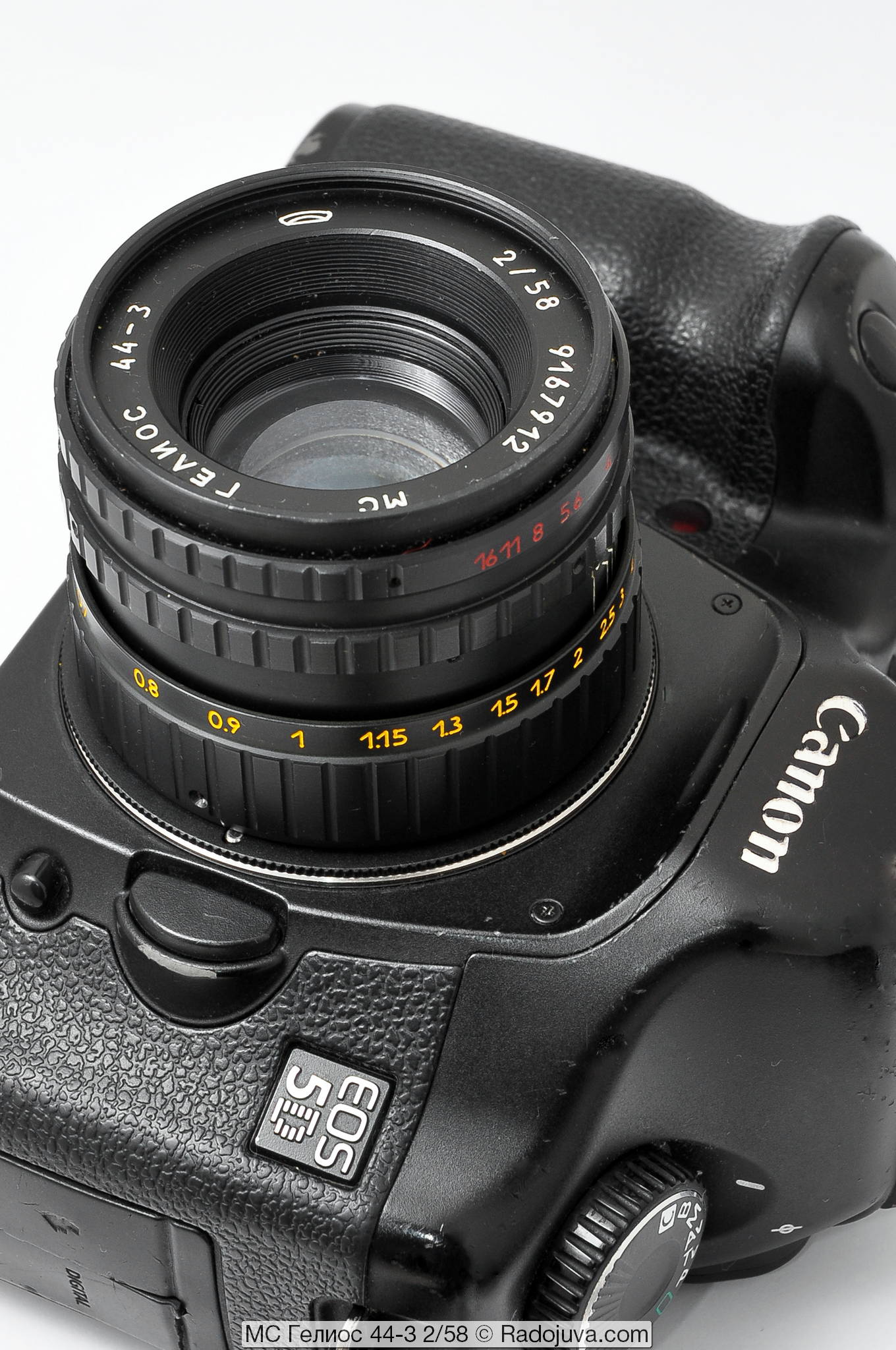
MS Helios 44-3 2/58. On a Canon EOS 5D full frame DSLR I used this lens with a simple adapter M42-Canon EOS
My experience
Of all the tried and tested lenses of the Helios-44 family, this Helios-44-3 MS 2/58 has personally sunk into me the most. I had several copies that I used in different years of my photo practice, all of them were good. Even problems with the use of adapters could not prevent sympathy for the Helios-44-3 MS 2/58. At the same time, for many years I tried a whole bucket of Helios-44-2 (about 10 different copies, different plants, different years of production) and not one of them stuck with me.
Personally, I believe that the Helios-44-3 2/58 is the best lens in the Helios-44 line without a blinking aperture. This is my personal opinion, it may not coincide with the opinion of other users. If in Helios-44-3 2/58 there were 13 petals, as in earlier versions of Helios-44, then he would not have a price.
Typically, Helios-44-3 2/58 MS is significantly more expensive than Helios 44-2 2/58. Despite his love for Helios-44-3 MS 2/58, they are not chasing after him. You can safely get acquainted with Soviet optics starting with Helios-44-2 2/58.
Comments on this post do not require registration. Anyone can leave a comment. Many different photographic equipment can be found on AliExpress.
Reviews for the Helios-44 2/58 lenses:
- Helios-44 2/58 [KMZ, 13 petals, M39, silver, No. 0220423]
- Helios-44 2/58 [KMZ, 8 petals, M39, silver]
- Helios-44 1: 2 F = 5,8 cm П [KMZ with replaced lenses, No. 0007220, review of the lens from the reader Radozhiva]
- HELIOS-44M 2/58 [KMZ, 8 petals, serial number 7843528]
- HELIOS-44M 2/58 [Jupiter plant, Valdai, 8 petals, serial number 8027170]
- HELIOS-44-2 2/58 [plant 'Jupiter', Valdai, 8 petals, serial number 83052779] + autofocus review
- MS Helios 44-3 2/58 [MMZ, 8 petals, 8619437, 9167912]
- MC Helios-44M-4 2/58
- Helios-44K-4 58mm 1:2 [KMZ, 6 petals, Pentax K]
- MC Helios-44M-4 58mm 1: 2 [plant 'Jupiter', Valdai, 6 petals] + autofocus review
- MC Helios-44M-5 58mm 1: 2 [Jupiter plant, Valdai, 6 petals]
- MC Helios-44M-6 58mm 1: 2 [plant 'Jupiter', Valdai, 6 petals]
- MC Helios-44M-7 58mm 1: 2 [plant 'Jupiter', Valdai, 6 petals]
- An article about most of the major modifications of the Helios-44 series
- Gallery of pictures on MC Helios-44M-4
- Look at modern the lenses 'Helios' can at this link
- A lot of Helios of all varieties can be found on ebay this link
Original 'Carl Zeiss Jena Biotar 2/58 ':
- Carl Zeiss Jena Biotar 1: 2 f = 5,8cm T [17 diaphragm blades, M42]
- Carl Zeiss Jena Biotar 2 / 58 T [12 diaphragm blades, M42]
- A lot of Biotars of all varieties can be found on ebay this link
Look at modern the lenses 'Zenitar' и 'Helios' can at this link.
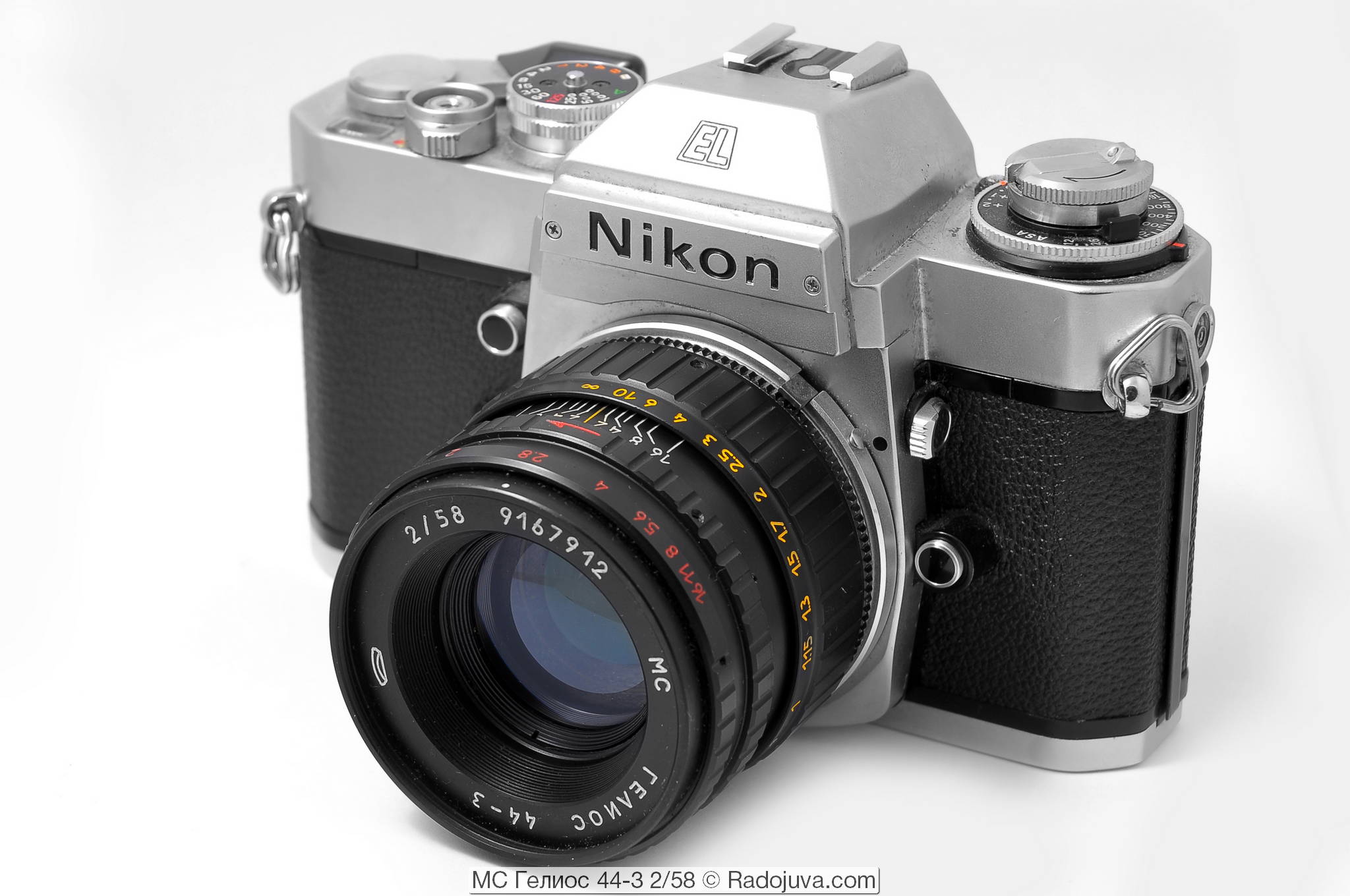
MS Helios 44-3 2/58. Lens shown on a film camera Nikon EL-2 mounted using a conventional adapter M42-Nikon F
Conclusions
MC Helios 44-3 2/58 is a good standard (in terms of focal length) fast lens. Some units are difficult to use on modern digital cameras due to the unusual design of the focusing ring, which complicates the use of adapters. Many amateur photographers use lenses of the Helios-44 family for a very wide range of photographic tasks, but they are mainly bought for creative photography, and in particular for creating a twisted bokeh effect.
Material prepared Arkady Shapoval. Training/Consultations | Youtube | Facebook | Instagram | Twitter | Telegram

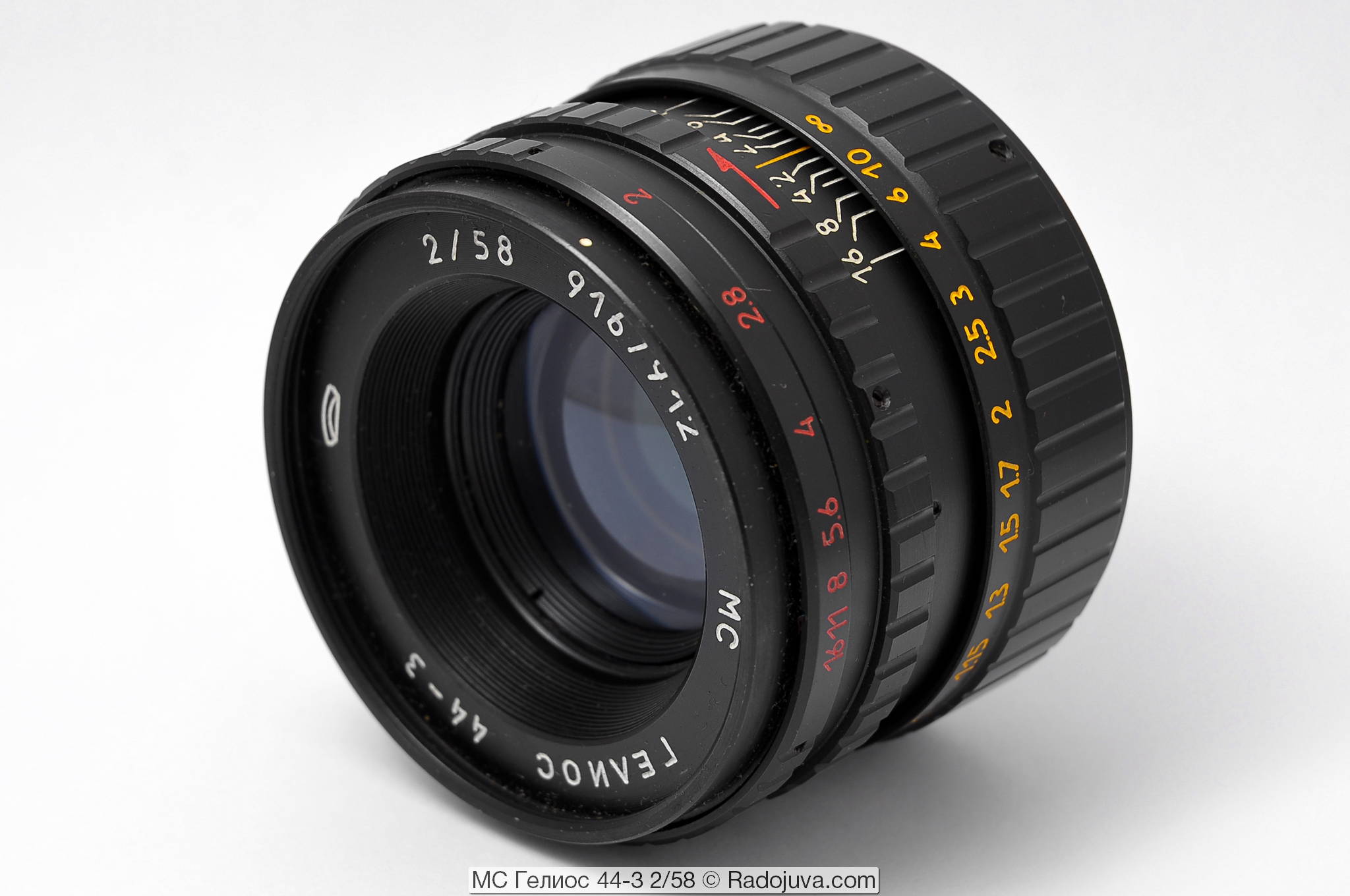

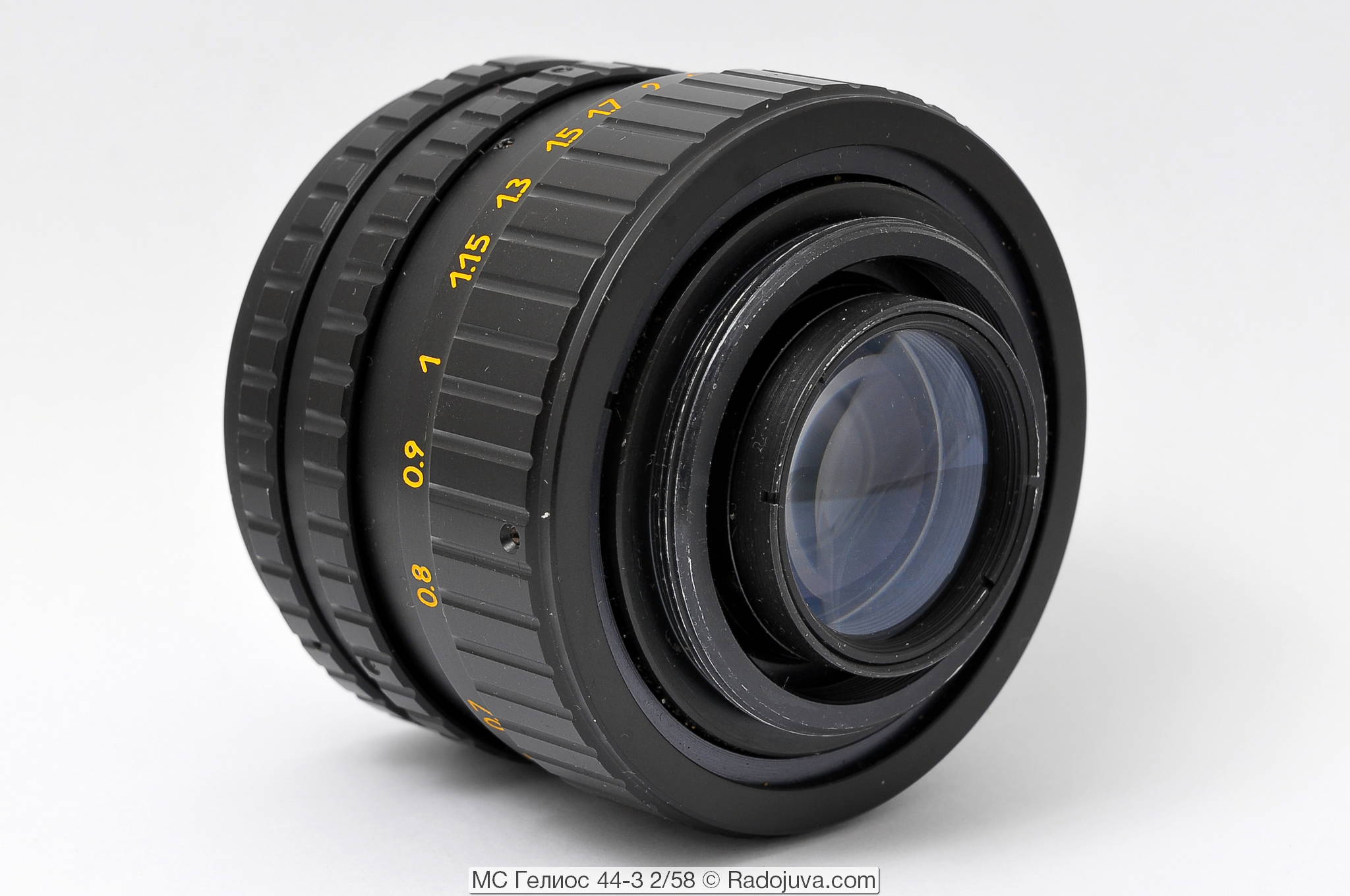
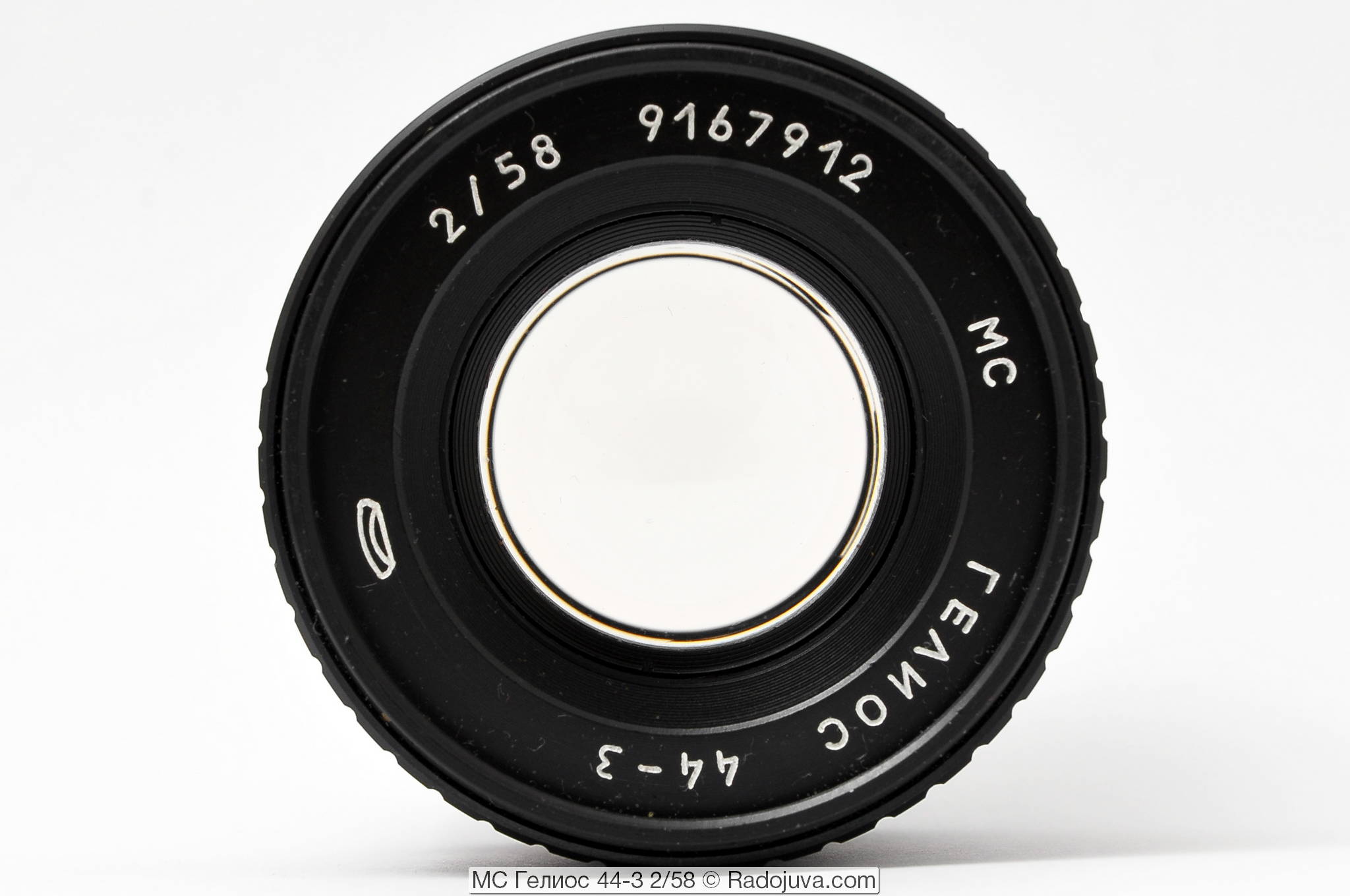
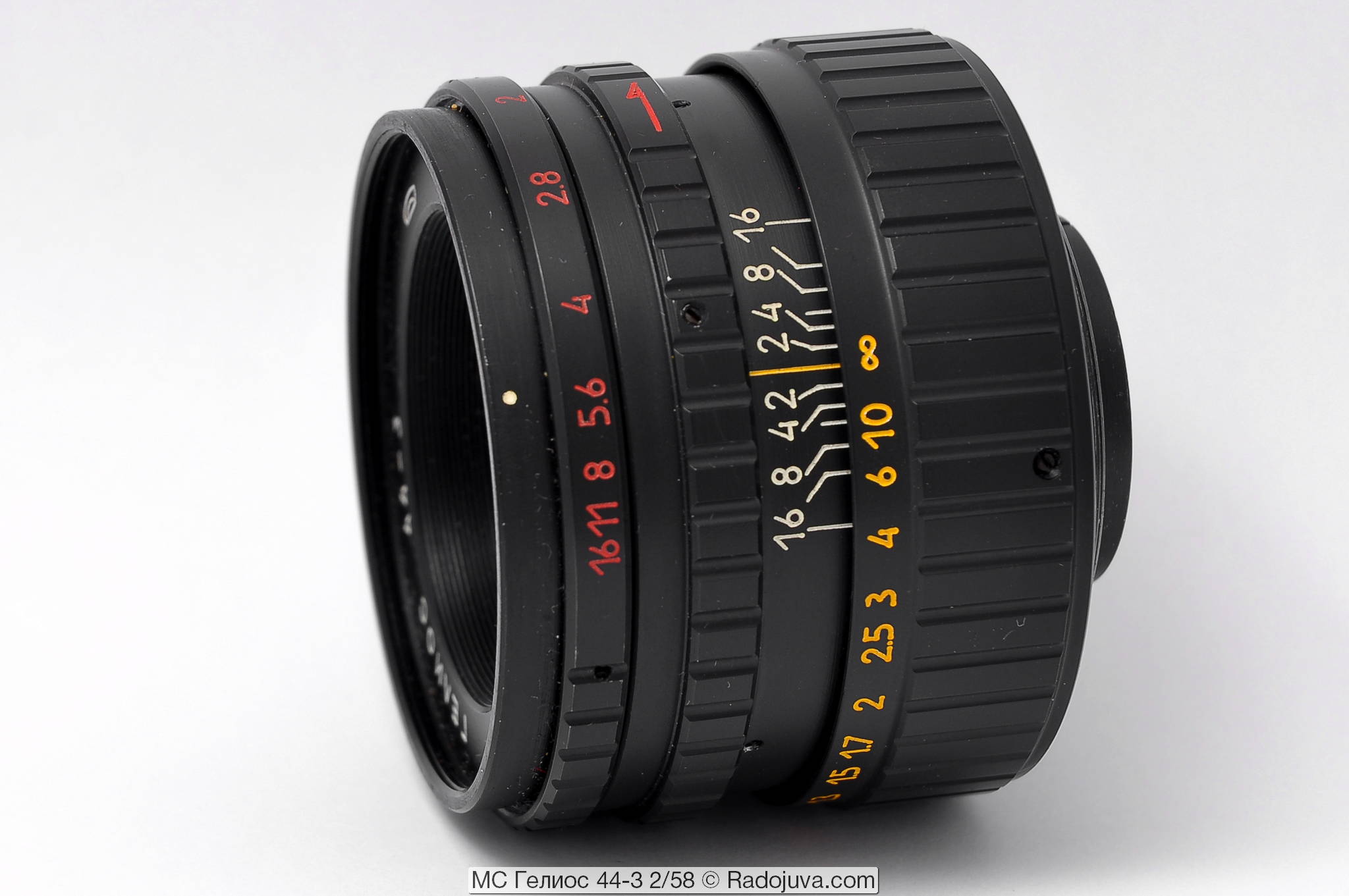

























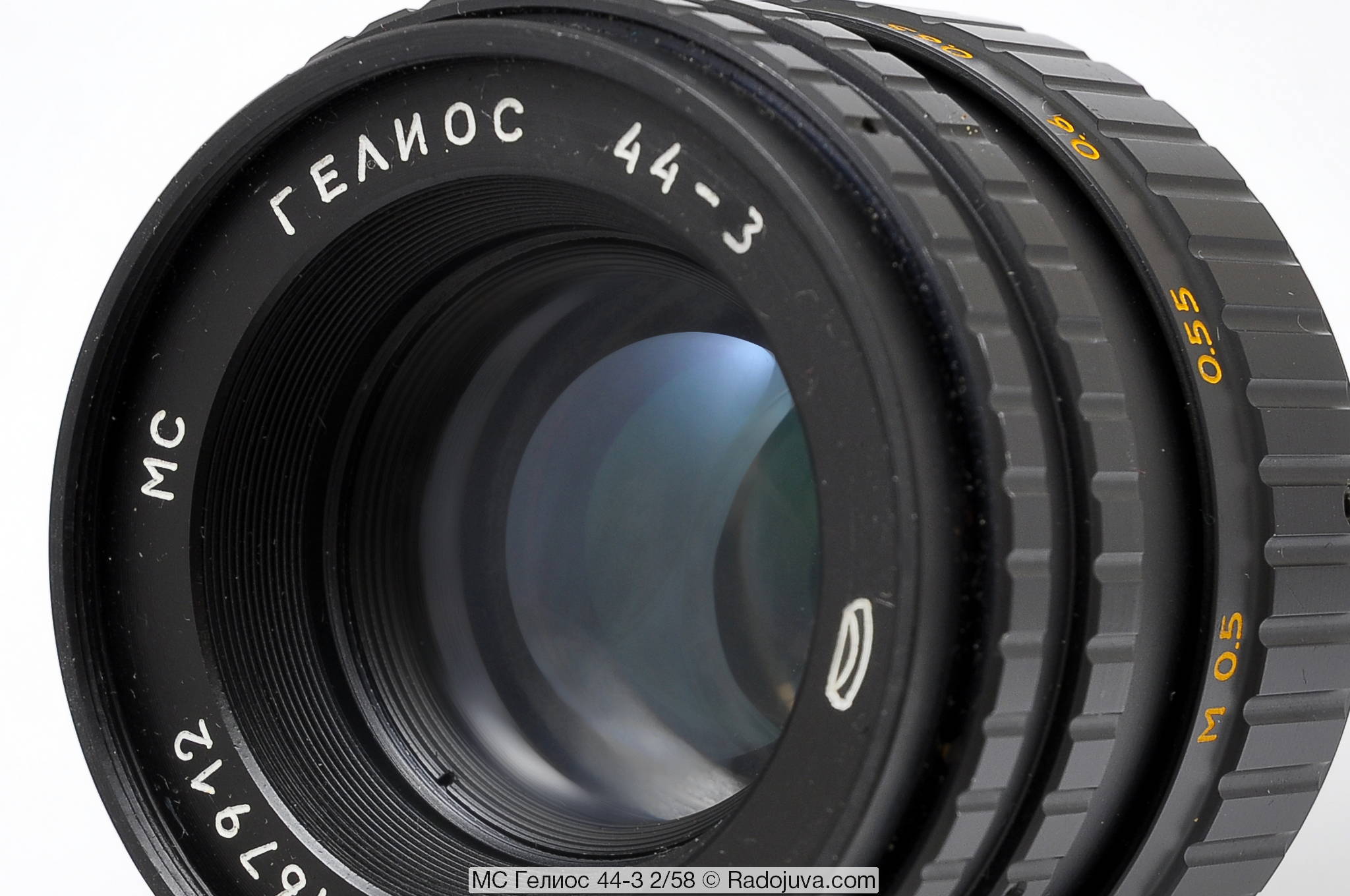
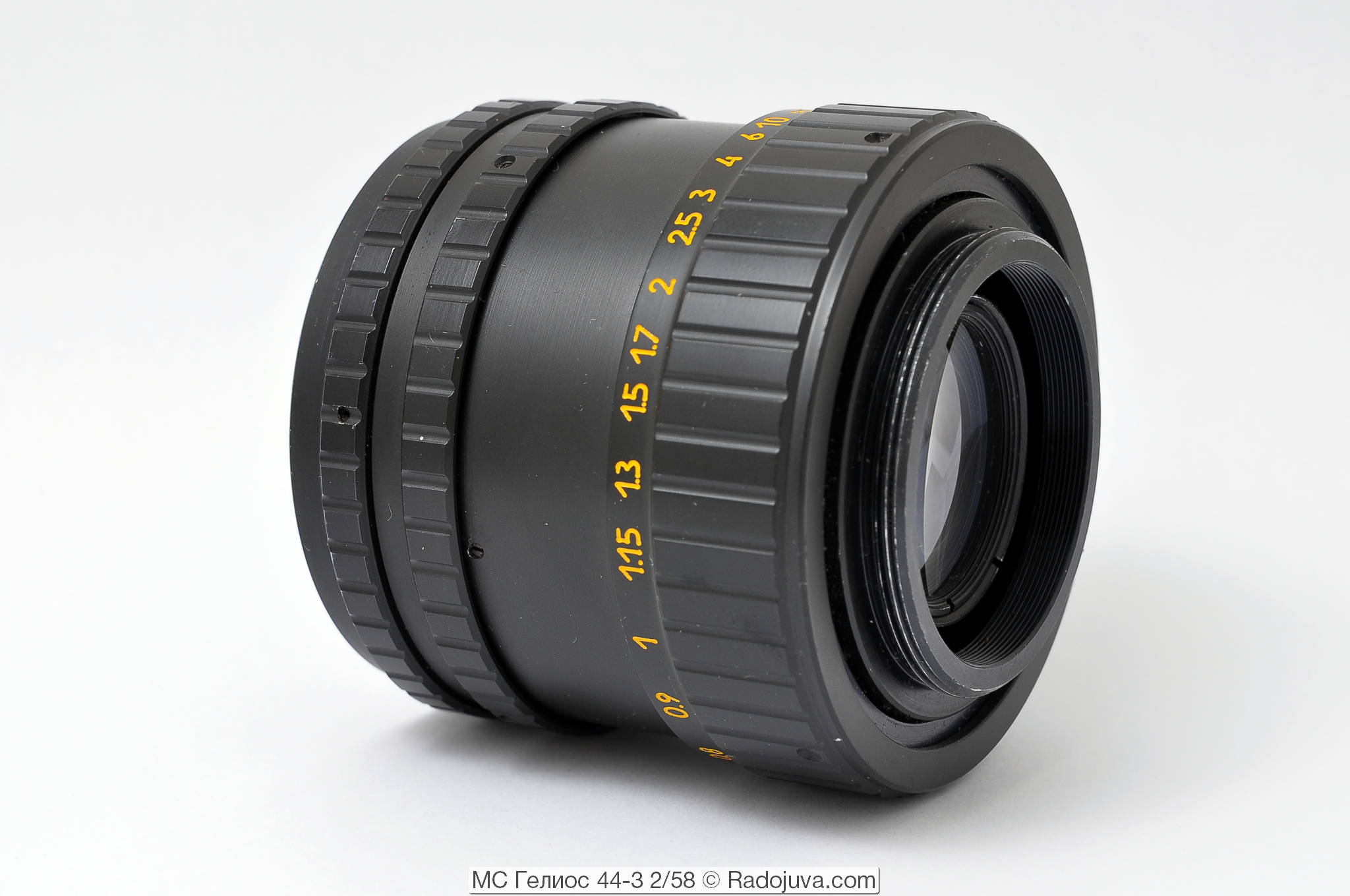
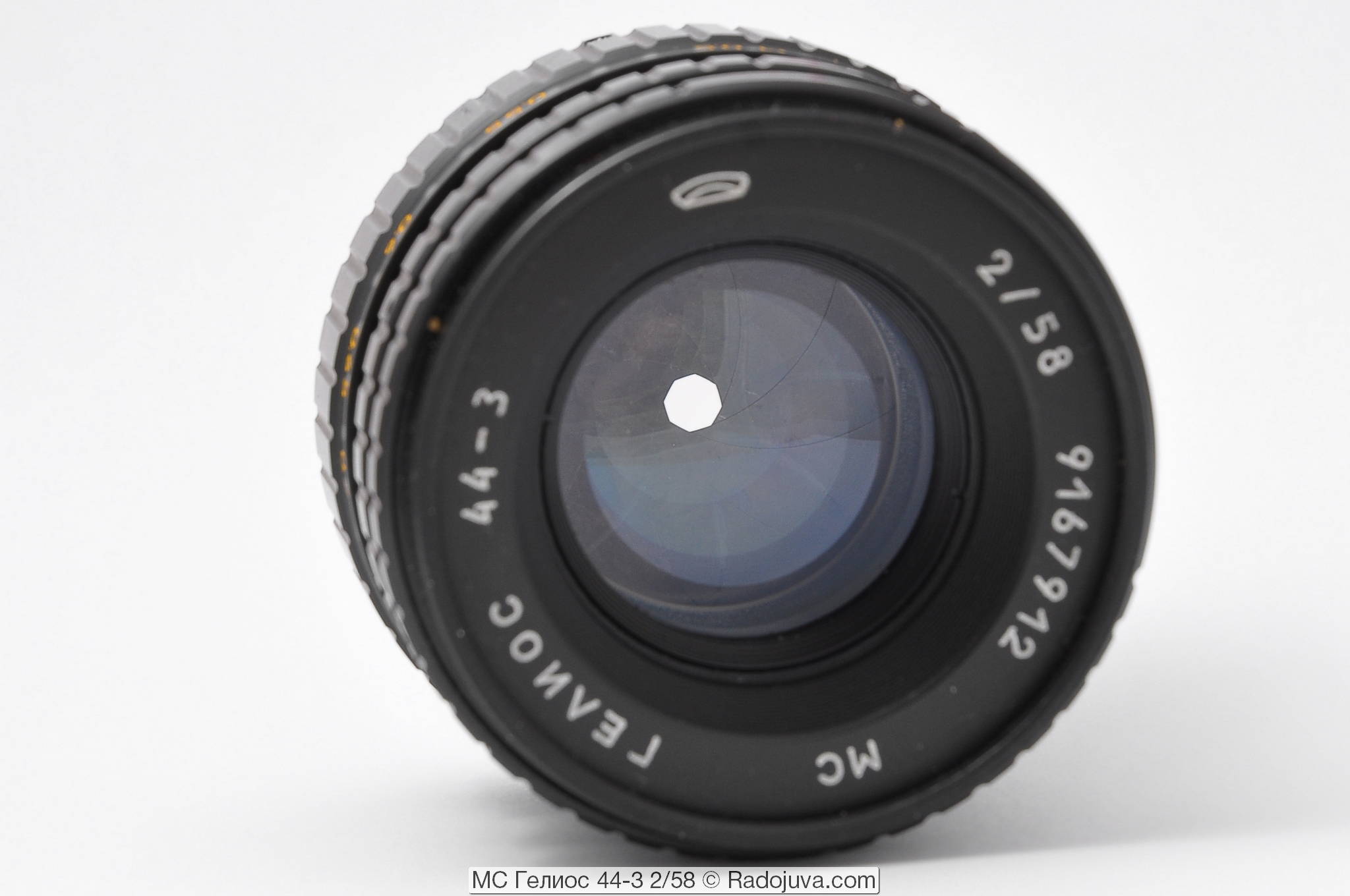
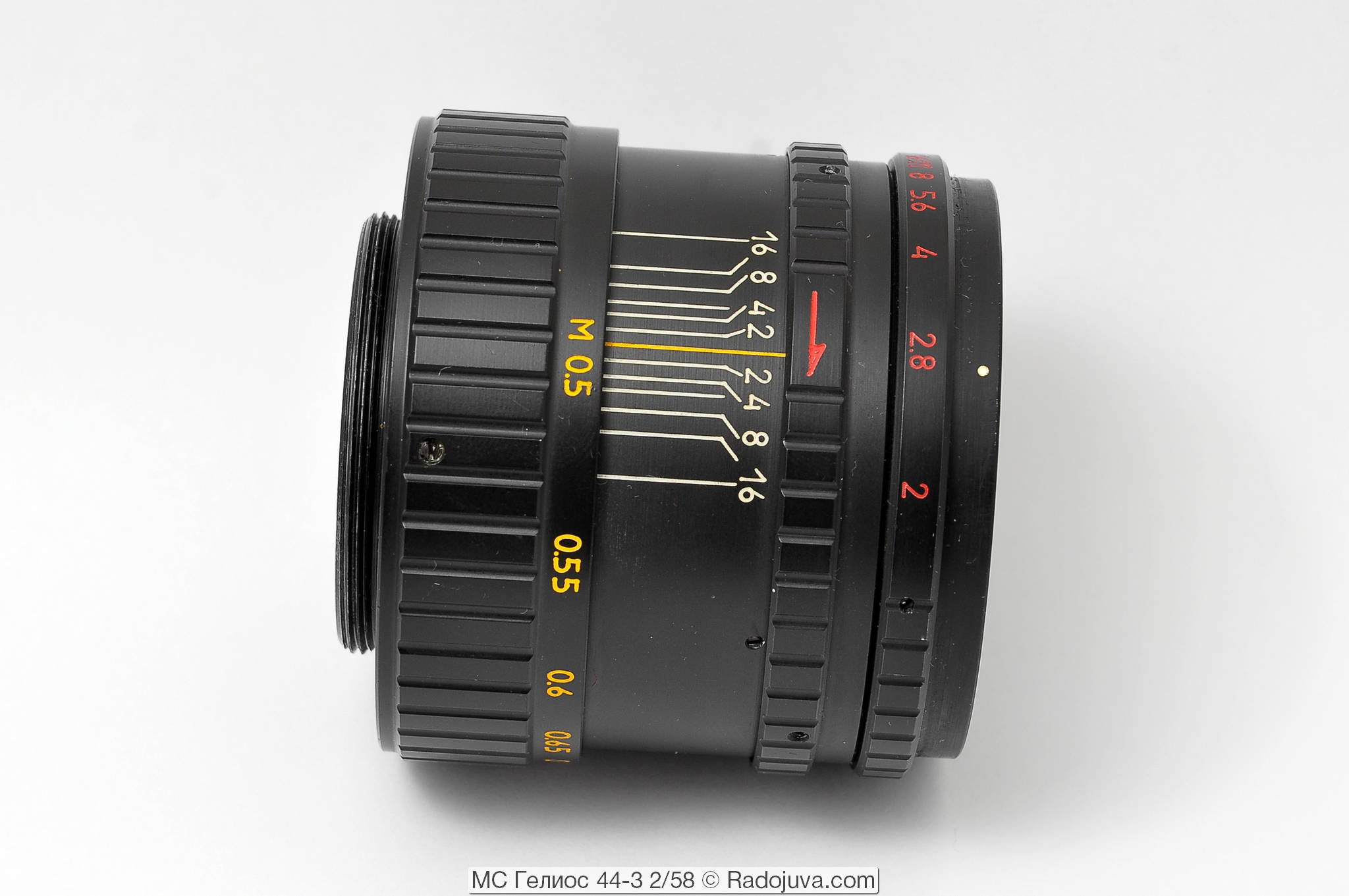
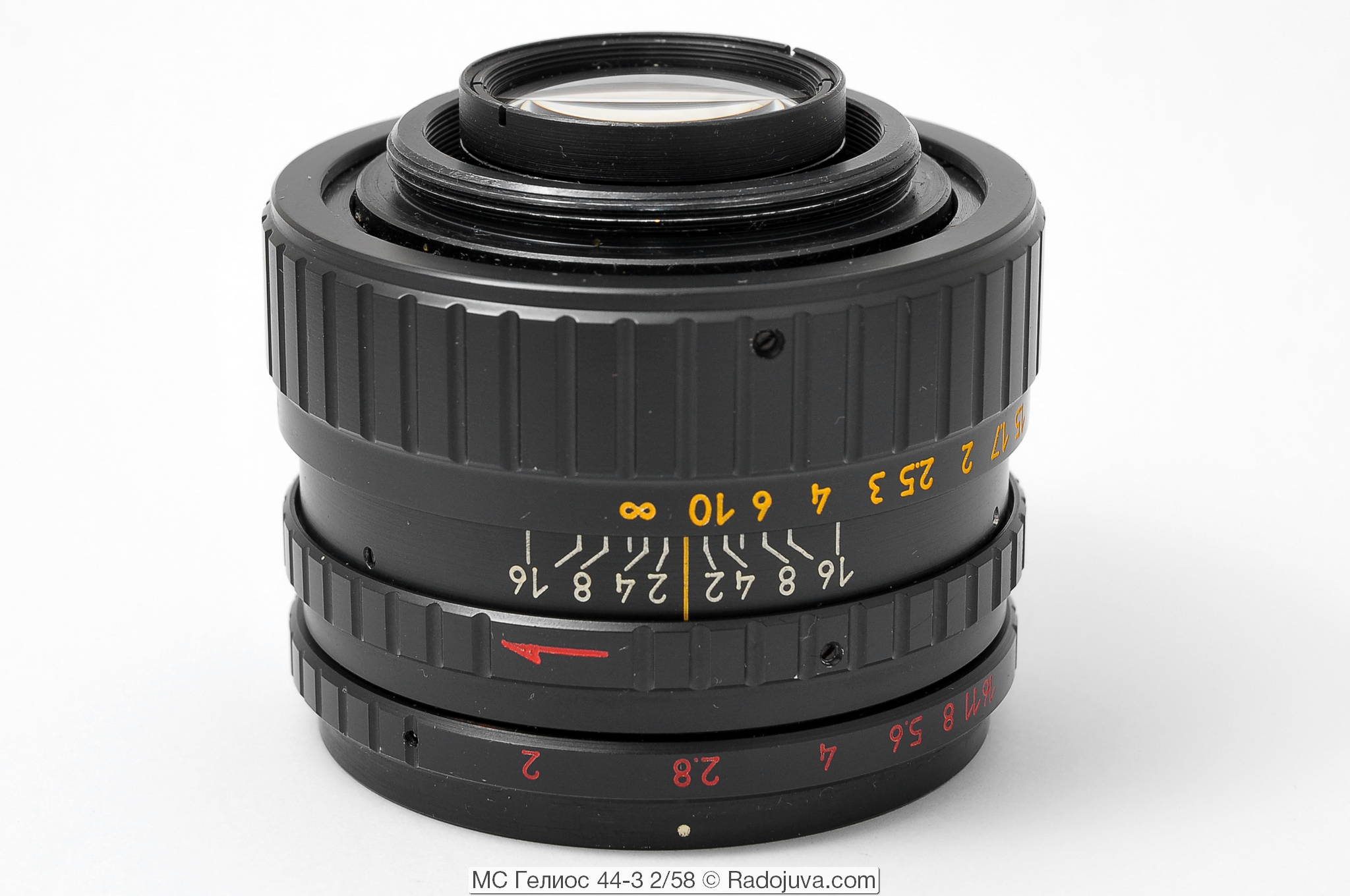

Good evening.
I have this Helios for two and a half years working with adapters with and without a chip, nothing interferes with focusing. I was very surprised that you have a focus ring pinched.
Forgot to write: year of release of 1991.
A very good lens in all respects. I use with Canon through an adapter with a programmable chip. Removed from his old Zenith-ET Vileika plant BELOMO. I must say that at one time there was a big shortage of equipment for the camera with this lens and the desired purchase of a good photographer even in our BSSR, where this instance was developed and produced. In my copy, the focus ring, oddly enough, precisely slides over the surface of the adapter and does not interfere with comfortable operation. One of the best lenses in my arsenal.
Tell the newcomer !! there is an opportunity to buy Helios 44m-3 so to speak for cheap, in excellent condition and I really liked it! But after reading about him, I'm afraid that he will cling to the focus ring like many. Poke your nose how to overcome this problem (stitch) or how ??? Maybe someone has a photo with examples. Thanks in advance. PS Canon carcass
And what prevents you from checking directly with your adapter before buying? In any case, the focus ring is removed without problems (fastened with three screws) and the end face is cut to size on a lathe with a good lathe.
but what about a "snug" diaphragm ?? do you need a specific adapter M42-EOS ??
If you do not have the appropriate adapter yet, I recommend that you pay attention before buying for the presence of a collar that blocks the diaphragm lead. Those. you need to choose the “correct” adapter or block the leash in any way you can.
I will consider thanks. And there will not be a reference which adapter is better to take? With delivery in Ukraine.
The main minus is the difficulty in focusing, even after adjusting the lens with the camera, there are misses. Sometimes it saves LiveView.
Last weekend I shot half of the wedding with this lens :) I was worried that then the marriage would go out of focus on my computer, but in fact everything worked out great! The most difficult thing was with group shots near the registry office with all the relatives of the newlyweds - the groups lined up 4-7 people in width. I had to move back 4-5 meters and shoot within the focus range. if not for the rear lens twisted at one time - such a trick would have failed. if anyone is interested, then later I can send some pictures here in the comments
these are the photos from the wedding (already processed) :)
https://pp.vk.me/c323425/v323425449/956e/T2wS503inbY.jpg
https://pp.vk.me/c323425/v323425449/95b3/Wp9fGB2T3Ks.jpg
https://pp.vk.me/c323425/v323425449/95a9/IzVAgI5J67E.jpg
https://pp.vk.me/c323425/v323425449/959f/C9NwRRpQkEM.jpg
https://pp.vk.me/c323425/v323425449/9595/1U2ZaDwK9bs.jpg
https://pp.vk.me/c323425/v323425449/9577/sI6bDbHMwkg.jpg
As a beginner in photography, after six months of using the SAL1855 kit lens, I tried the M42 + Helios 44-3 (MS) adapter and ... was stunned by the difference:
http://img.by/i/kP0ew.jpg
http://img.by/i/E1aqL.jpg
http://img.by/i/6SYRb.jpg
http://img.by/i/jRvCH.jpg
http://img.by/i/aWJZb.jpg
The video on it is also with nice colors, but the lack of autofocus still limits its use. Although, perhaps, I am just a beginner and did not get used to manual settings.
About my copy I will add that the focusing ring does not cling absolutely neither to the adapter with "dandelion", nor to the usual simple one.
Now the AF fix is on fire, but I also want an old reliable glass (like MINOLTA AF 50mm f1.7) with the quality of Helios 44-3, but with autofocus. And then the reviews about the new glass are reduced to plastic quality.
I have an amazing option. Outwardly, he is 1 in 1 Helios 44-3, as you have. But it engraved 44-2 and without MS. Although, judging by the color of enlightenment, it is similar to MS. But in terms of resistance to Backlight, it is still single-layer.
http://img-fotki.yandex.ru/get/5013/12363252.0/0_cd76e_38929a5b_XXXL.jpg
http://img-fotki.yandex.ru/get/9516/12363252.0/0_cd76f_c3034056_XXXL.jpg
I have never seen information on my lens, some rarity.
The lens is neither sharp nor soapy. For portraits, that’s it. But for Rostovs on crop, it is not suitable, because it is noted here, even in the open large DOF, there is no separation of the object from the general background, and there is not enough sharpness. So I would say this fix for a shoulder belt, not more.
I liked the transfer of volume in a pseudo macro:
http://img-fotki.yandex.ru/get/9512/12363252.0/0_c56b4_acedba57_XXXL.jpg
It turned out, in my opinion, a three-dimensional picture.
Focusing is smooth. Ring preset like. I met the same one on the Pentacon 135 f 2.8, which is with 15 petals.
These are Helios 44-2 of the Belarusian spill, the Zenit-ET whale lens of the Vileika Zenit plant.
In me, there is such an instance.
And on that little ring the focus is a chipleє body, then everything is proto. You take sandpaper to the smokers, put it on the stylus, take the focus and wipe it on an uneven surface. I’m happy!)
On the Pentax K5 II, Floating is like a riba in water) I have nothing to eat.
please tell me Arkady on nikon d 90 industrial 29 and helios 44-3 ms what kind of adapters are needed? and will it autofocus or have to work with pens?)))
Good day.
Today I became the owner of this lens. Number 9237901. So far, I have not been pleased with anything. The condition is of course not bad, but it scours soap at a completely open hole, sharpness starts at 4-5.6. Using with an adapter for Nikon with a lens. Can I do something wrong?
yes, that's the problem - https://radojuva.com.ua/2013/02/adapter-m42-nikon-with-lens-quality/
I took off a little today after cleaning the lens
http://photo.qip.ru/users/rychkv/4241668/105100538/
http://photo.qip.ru/users/rychkv/4241668/105100616/
http://photo.qip.ru/users/rychkv/4241668/105100669/
http://photo.qip.ru/users/rychkv/4241668/105100729/
http://photo.qip.ru/users/rychkv/4241668/105100791/
Actually the glass itself and of course what happened in a hurry. I actually shot it on the crop through the adapter to Nikon without a lens.
It’s a pity I still got the glass with a flaw. There are small chips on the lens itself. But it seemed to me that it doesn’t affect the quality at all. I’m honestly glad that such a miracle appeared. I took ET for 500 wooden ones.
Arkady, Good afternoon, I found this Helios 44-3 at home, I have Nikon D 5100. What is the best adapter to use to make it work normally?
PS I read the article twice, I just need advice on what to choose.
Hello, help! Found at the grandfather Helios 44-3 as new!
I bought an adapter for Canon 60D with a programmable chip, programmed a focal length of 56mm, for some reason I could not program the aperture, it remained 1.0. I sharpened the focus ring to move freely. Everything works, focuses, picks as it should. One problem! On the viewfinder screen, it shows an incorrect brightness, or in general blackness or vice versa is illuminated, and the picture is different. What to do help !!! The lens then takes a picture, but because of this it is difficult with it.
To begin with, the focal length is not 56mm, but 58mm. Next, program the focal length and aperture, if possible, micro correction for focusing (in accordance with the adapter manufacturer’s instructions) (for this you need a test table to check the front / back focus). Manual optics are best used in LiveView mode - more precisely metering and focusing is easier. If you want to work with the viewfinder, use exposure lock, then cover the aperture to the desired one and shoot. In general, everything is individual, experiment and learn, and you will succeed.
And Photoshop, specific multilayer enlightenment, RAW-temperature and so on. The lens is very good. Ease of use is like 44-2, everything else is no worse than 44m-6, or even better.
Agree with this: http://allphotolenses.com/reviews/item/c_7.html
In the lenses of the 80s, the focus ring really abuts against the adapter. It is eliminated simply. It is necessary to remove the focusing ring and grind it inside about 1 mm in the place where the ring rests on the frame. I have already done this on 3 lenses. Advantages of the 80s lenses in the blackened diaphragm. In the lenses of the 90s, there is no blackening of the aperture.
Please give me a link that details how to sharpen the focus ring.
This is not described anywhere. Remove the focus ring (it is attached with three screws) and see where it rests on the frame.
Thank you, but I didn’t need it, the lens of 93 is no longer experiencing any problems with the focus ring and infinity.
I bought an M42 adapter for the Canon 700D, focusing works completely, does not rest, does not jam.
Arkady, hello! And which of the Helios is better for Nikon D80?
MS Helios-81N, 123n, 40-2N
About the fact that the focus ring sticks out too upset because there is no way to focus, it turned out that nothing needs to be sewn inappropriately, you need to choose an adapter with a depression for the focus ring. On Ebay, I took two types of usual with a flat platform that contacts the lens that catches and there is also an adapter with protruding edges 4 mm wide on the inside and outside and about half a millimeter deep maybe less, I thought for what reason it was not in vain.
They have two different versions of the focusing ring (both BelOmo "). There is when flush with the “surface” of the adapter, and if deeper. There will be problems with the second option. Everything is in order for me, everything was fine on the first adapter that came across.
Arkady, hello! For OLYMPUS E-PL5 which of the Helios is better suited? Thank you!
Anyone you like :)
Another question), is such an adapter suitable for OLYMPUS E-PL5 and the lens from this review?
Yes, it does.
I have a Sony SLT-A35Y + Helios 44-3 and immediately didn’t want to work in pairs, I had to make a couple of improvements:
1. Between the lens and the adapter M42-AF put a plastic ring-gasket with a thickness of about 0,25-0,5 mm, otherwise the focus ring rested on the adapter;
2. Under the rear lens I put a wire “adjustment ring” made of a thin Chinese paper clip about 0,5 mm thick, otherwise not like infinity, beyond 5 meters everything was out of focus. But even after installing this ring, there is no infinity, the limiting focusing distance is about 40-50 meters. I did not want to put a thicker ring, for such a distance there are whale lenses. After installing this ring, the focus confirmation began to work correctly, before that it missed a bit. Unfortunately, there are no programmable chips for the M42-AF adapter.
The minimum focusing distance after modifications is approximately 45 cm.
About grinding the focusing ring.
As I wrote in a previous comment, there is no need to undercut anything. Put a spacer of the minimum thickness - mine is thinner than 0,5 mm - and this is quite enough. The first pad was made of cardboard from some kind of advertising flyer: http://c2n.me/jqoZlt.jpg
http://www.ebay.com/itm/150957407930?_trksid=p2059210.m2749.l2649&ssPageName=STRK%3AMEBIDX%3AIT
Here’s the ROXEN adapter with which you don’t need to sharpen anything, the aperture and focal length change on it, but I still have not figured out how the focal length changes, the third generation adapter works with canon 650d and 5dmk3.
Hi) I want a new (not expensive) lens. But I have a Nikon in 5100 what should I do, will this suit me or not? (To be honest, I don’t really understand this, what can you advise?